User Opinions
|
||||||||||
|
|
|
| Wed Aug 27, 2008 - 2:24 AM EDT - By Andre Kibbe | |
|
|
|
|
|||||||||||
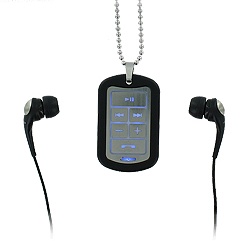
More than an OS upgrade, more than WiFi, more than RAM measured in Gigabytes, Palm needs to bring their phones in line with the 3.5mm jack specification that's standard on music players (which they have with the Treo Pro since I wrote this review), but still inexplicably uncommon on cell phones. The Treo's and Centro's 2.5mm audio jack is the phone's biggest Achilles' Heel. Having an 8GB microSD card full of music, but then having to use a 2.5mm headset or adapter is like putting high test gas into a Model A.
In theory, Bluetooth stereo headsets are a great way to circumvent the jack issue, but many of them are cumbersome, integrating the wireless circuitry in the earphones themselves. For me, the ideal headset would have the lightness and portability of earbuds, but with wireless capability.
Jabra's design for the BT3030 is a stroke of genius. It's basically a lanyard-worn pendant that acts as a wireless controller that feeds its audio to a 3.5mm wired headset. Why didn't someone think of this before?
The answer is simple: someone has thought of this before. Sony Ericsson offers the pendant-style HBH-DS970 Bluetooth Stereo Headphones that are top notch. Unlike the Jabra, the SE features an LED screen with caller ID. It's also more expensive than the Jabra by half.
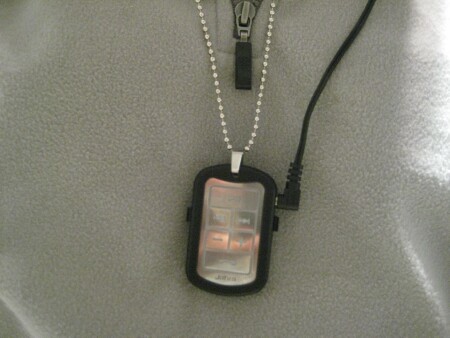
The BT3030 is designed to look and be worn like a dog tag. The lanyard is actually a chain, and the front and rear surfaces are brushed steel. The microphone is built into the black plastic frame that encloses the front and rear plates, keeping the load off the headphone wire. The controller inlay on the front plate resembles the flat keypad of the Motorola Razr. The translucent company logo, button icons and borders are multicolor LEDs that function as status indicators, glowing blue by default in normal use. The logo, for instance, is solid green when fully charged, flashing green when charging, yellow when 70% charged red when power is low.
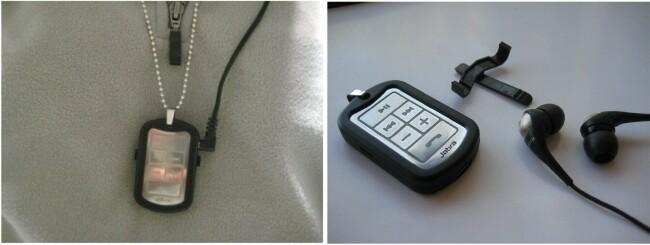
I much prefer the Jabra's controls to Sony Ericsson's. The buttons are grouped together, big and obvious. Sony places their small track skip slider switch on the side, while placing the play/pause button on the front.
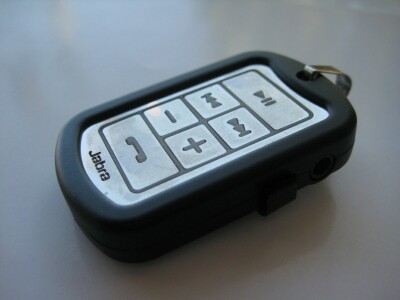
The unit has a Mini-USB socket for use with the included wall charger. As is increasingly common with Jabra headsets, there's no provision for charging via computer. The BT3030 is rated at 8 hours talk time, 230 hours of standby time, and 7 hours of music playing time.
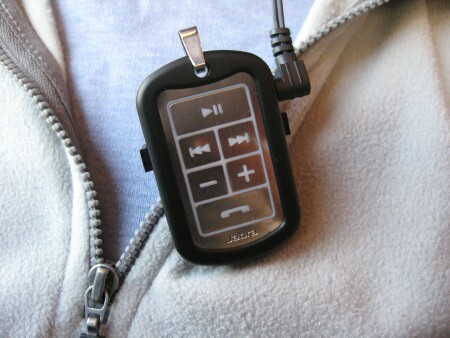
The Jabra and the Sony are almost identical in weight, but the Jabra's dog tag design gives it more even weight distribution than the Sony's oblong profile. This allows the BT3030 to be used with a clip instead of the chain. Sony's lanyard integrates the earpiece wire; on the Jabra, the headphones are separate, plugging into the unit. When hung from the neck, Sony's lanyard is less cumbersome, but wearing the Jabra with the clip is even less cumbersome.
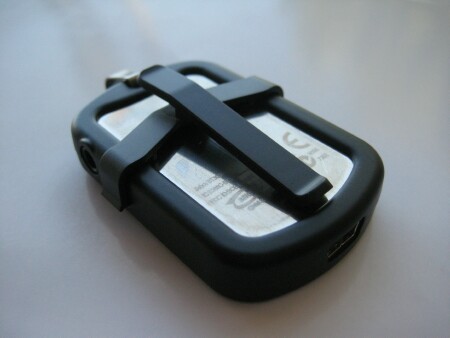
Wearing the Jabra with the chain looks irresistably cool, especially if you accessorize yourself with a fatigue top from the Army surplus store. The only problem the chain presents is occasional tangling with the headphone wires. I used the included headphones and a couple of other headphones of different lenghts, and even the shortest one (the Jabra's) tended to cross with the chain from time to time. The clip is definitely the easier of the two ways to wear the unit.
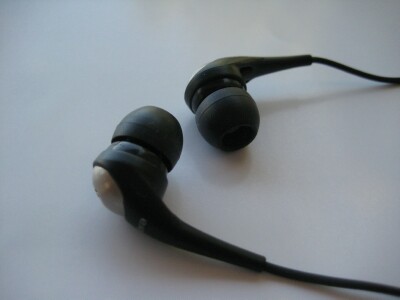
The headphones' stereo cable is short to minimize slack. Because it's short, you'll need to substitute it with a different pair of headphones if you want to avoid carrying a second pair around for use with your laptop. That's too bad, since the headphones are keepers. On the other hand, the controller supports multi-point Bluetooth, so your can pair your laptop and cell phone simultaneously. The eartips do a great job of blocking out ambient noise, and do an even better job of staying put in your ears. In addition to the medium-sized eartips already on the earphones, a pair of large and small eartips are also included.
Setting up the Jabra was a no-brainer. Out of the box, pairing took less than a minute. The unit enters an auto-pairing mode when it's powered on for the first time, so it's detected rapidly when you run the Treo's Handsfree Setup utility and enter the four-zero passkey. Charging is supposed to take two hours, but I got less than four hours of music after my first two-hour charge. I charged it for another two hours, making sure the logo went solid green, and managed to go for six hours before the unit chimed its cue for recharging.
As mentioned, the music playback buttons make their operation self-evident, and unlike some stereo headsets I've used in conjunction with Softick Audio Gateway, the Jabra supports AVRCP (the BT profile for playback control) flawlessly. The answer/end button is multifunction. To answer an incoming call, you tap this button. To redial the last number dialed, you double tap the button. To reject a call, you press it for about one second. If you have voice dialing enabled through software or your carrier network, you can voice dial by pressing the answer/end button and speaking the contact name. To power the headset on or off, you have to press and hold for about four seconds � uncomfortably long, in my opinion; or until you see a burst of flashes from the LED.
Virtually all Jabra headsets north of $60 have great clarity for music due to noise reduction that works as advertised. It's a good idea to make your baseline volume setting on the phone itself, around 65%, then make further adjustments with when necessary with the headset. Pumping up the volume primarily on the handset tends to introduce distortion. Like most headsets, the Jabra keeps the volume across the frequency range rather uniform, so I like to boost the lower midrange in pTunes' EQ to give the sound some weight.
I test headsets by making and listening to calls to voice mail, both by headset and handset for comparison. The Jabra's outbound sound quality is nothing exceptional. The noise reduction is noticeable between words, but I have yet to hear a headset with outbound sound as intelligible as a handset.
The inbound sound quality, however, is on the upper end of Bluetooth headsets. Like all headsets, the highs are a little muted, but the hissing in the background is less noticeable than most non-Jabra models.
Just for the way it solves cord management issues alone, the SP3030 is a great product. Like an iPod Shuffle, you can clip it to your collar, and keep the amount of headphone cable in your way to a minimum. Unlike a Shuffle, you can have as much music available to you as your memory card allows. Whether you wear it clipped, or hung as a dog tag, it's great to have your MP3 player's music controls instantly accessible.
The highly original industrial design, great music quality and operational simplicity of the BT3030 make it unquestionably my favorite Bluetooth product this year. If you use the Treo instead of dedicated digital audio player, consider making the Jabra your default music controller.
|
|
||||||||||||||||||||
|
Copyright 1999-2016 TreoCentral. All rights reserved :
Terms of Use : Privacy Policy
TREO and TreoCentral are trademarks or registered trademarks of palm, Inc. in the United States and other countries;
the TreoCentral mark and domain name are used under license from palm, Inc.
The views expressed on this website are solely those of the proprietor, or
contributors to the site, and do not necessarily reflect the views of palm, Inc.
Read Merciful by Casey Adolfsson